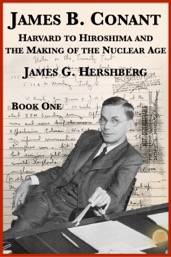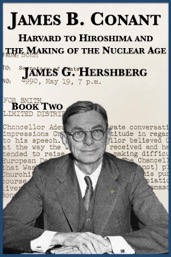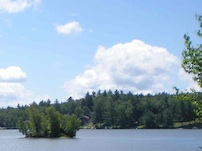 . . . . .
. . . . .
$9.99 on Kindle
Apple Books, Kobo, . . . . .. .Apple Books, Kobo,
Google Play . . . .. . . .. . .. .Google Play
Click here for both eBooks on Kindle
(covers by Susan Erony)
James B. Conant: Harvard to Hiroshima and the Making of the Nuclear Age by James Hershberg (455,000 words, 31 illustrations)
James B. Conant (1893-1978) was one of the titans of mid-20th-century American history, attaining prominence and power in multiple fields. Usually remembered as an educational leader, he was president of Harvard University for two tumultuous decades, from the Depression to World War II to the Cold War and McCarthyism. To take that job he gave up a scientific career as one of the country’s top chemists, and he left it twenty years later to become Eisenhower’s top diplomat in postwar Germany.
Hershberg’s prize-winning study, however, examines a critical aspect of Conant’s life that was long obscured by government secrecy: his pivotal role in the birth of the nuclear age. During World War II, as an advisor to Roosevelt and then Truman (on the elite “Interim Committee” that considered how to employ the bomb against Japan), Conant was intimately involved in the decisions to build and use the atomic bomb. During and after the Manhattan Project, he also led efforts to prevent a postwar nuclear arms race between the United States and the Soviet Union that, he feared, threatened the survival of civilization — an apocalyptic prospect he glimpsed in the first instant of the new age, when he witnessed the first test of the new weapon at Alamogordo on July 16, 1945.
“... a vivid inquiry... a model of historiography; evocative reading...[Conant was] central to atomic policy and progress; the bomb would be as much Conant’s as it was anyone’s in Government. His inner response to that burden responsibility has long been obscured, but it is illumined here.” — Philip Morrison, The New York Times Book Review
“In his splendid portrait of Conant, James Hershberg has illuminated the life of a pivotal figure in the making of U.S. nuclear, scientific, educational and foreign policy for almost a half-century. But the book is much more: It is not only an insightful narration of Conant’s life; it is also a brilliant and important account of the making of the nuclear age, a chronicle that contains much that is new... Hershberg’s superb study... is a chronicle of Conant’s moral journey and we are the wiser for his having charted Conant’s path.” — S.S. Schweber, Washington Post Book World
“James G. Hershberg ably comes to grips with Conant and his hazardous times... His book is vibrantly written and compelling, and it breaches Conant’s shield of public discretion in masterly fashion, making extensive use of unpublished interviews, diaries, reports, and correspondence pried from private and governmental repositories. It is a huge, ambitious work — a history of the Cold War as Conant encountered it as well as a study of the man.” — Daniel J. Kevles, The New Yorker
“... a well-written, comprehensive, nonjudgmental but sensitive biography... Conant was involved in so many and such critical events that students of almost any aspect of our public life over the past half-century will find useful the new material and helpful insights in this book... This fine biography of one of the most important and complicated of America’s twentieth-century leaders immediately establishes James Hershberg as one of America’s outstanding young historians.” — Stephen E. Ambrose, Foreign Affairs
“... magnificent... Any reader interested in nuclear weapons, Cold War history or American politics from FDR to JFK will find this biography riveting.” — Priscilla McMillan, Chicago Tribune
“... masterful... The prose is clear, the narrative forceful and the author’s judgments are balanced and judicious. This is simply splendid biography... The highest praise one can give for a book of this sort is that the historian has not shrunk from speaking truth to power. This book quietly but insistently does so. It should be read by the public at large as one of the definitive texts on the cold war and the nuclear age... Hershberg’s triumph is that he has prevailed over all the official lies to give us one more layer of the historical truth.” — Kai Bird, The Nation
“... riveting... an impressive achievement... honest and comprehensive in its scholarship, the author has shown himself to be a historian of notable achievement and promise.” — McGeorge Bundy, Nature
“Hershberg’s outstanding, balanced biography lifts the self-imposed secrecy surrounding a key architect of U.S. Cold War policy and of the nuclear age.” — Publisher’s Weekly
“... [an] impressive and substantial achievement. [Hershberg] has used the life of one strategically placed individual to illuminate the most important issues surrounding America’s role and conduct in the nuclear age. His book will be invaluable to scholars assessing the impact and legacy of the group who acquired the epithet ‘wise men’ now that the Cold War has receded.” — Carol S. Gruber, Science
“... definitive... a far more textured picture than one finds in Conant’s own guarded and unrevealing autobiography... an important and rewarding book... illuminating... Conant led a remarkable and eventful life in remarkable and eventful times. James Hershberg has explored that life, and those times, in exhaustive and revealing detail.” — Paul Boyer, The New Republic
“James G. Hershberg has achieved the impossible. He has written a huge biography of a Harvard president that is fascinating, informative and as valuable a piece of American history as anything I have read in years... Mr. Hershberg has brought us back vividly to an age that seems remote, so long ago, but the questions about nuclear proliferation are the same, even while the answers are still ambiguous. As we watch men struggling with unanticipated post-Cold War problems and civil wars sprouting like Jason’s men at arms, it is good to read this story about a complex man who deserves an important place in our history because he helped make that history possible.” — Arnold Beichman, The Washington Times
“... engrossing... A magisterial study of an awesome and intriguing public career.” — Kirkus Reviews
“... entertaining... thought-provocative.” — Dick Teresi, The Wall Street Journal
“Hershberg’s book helps us more clearly understand the postwar Establishment and offers a challenging appraisal of the role of elites, of universities and of the state.” — Gar Alperovitz, In These Times
“Hershberg deserves great credit for cracking a tough New England walnut, analyzing this very important public figure, demonstrating how he fit into his own time and showing us what we can learn from the man.” — Daniel R. Mortensen, The Friday Review of Defense Literature
“... a compelling account... an engaging examination of one of the central figures of the nuclear age. It succeeds in showing ‘one man’s intersection with great events and issues’ and in the process illuminates those issues for us all.” — American Historical Review
“... well-written... Conant’s participation in one of our country’s most dynamic periods is, thanks to Hershberg, now much better understood.” — Library Journal
“A reader of the book will enter the realm of the greats, the shapers of worlds created by the atomic blasts at Hiroshima and Nagasaki... Conant was no bit player in Cold War history... [the book is] very successful in weaving Conant’s subsurface persona in with his ups and downs as a prominent and committed public figure. And it leaves out little detail in describing top-level decisions involving the Cold War geopolitics of nuclear weaponry. Conant was a participant in most of these decisions—with Presidents Roosevelt and Truman themselves, their Secretaries of War and State, and, of course, all the major scientific figures of the time.” — Chemical & Engineering News
“A wonderfully rich portrait that emerges from a carefully documented account of Conant’s role in the development of the atomic bomb and post-war nuclear policy... An extraordinarily well written text... Hershberg lays bare the person behind the persona — warts, dimples and all.” — Stanley Goldberg, Bulletin of the Atomic Scientists



